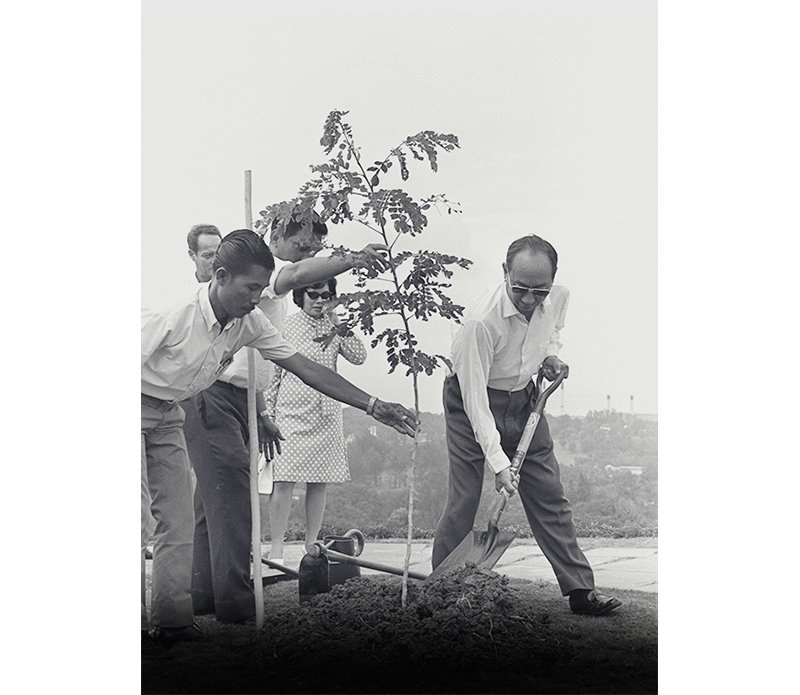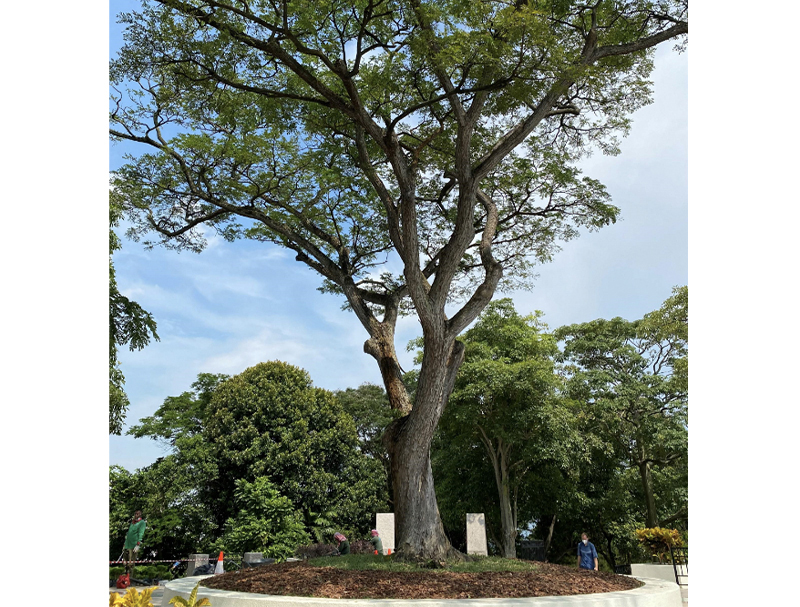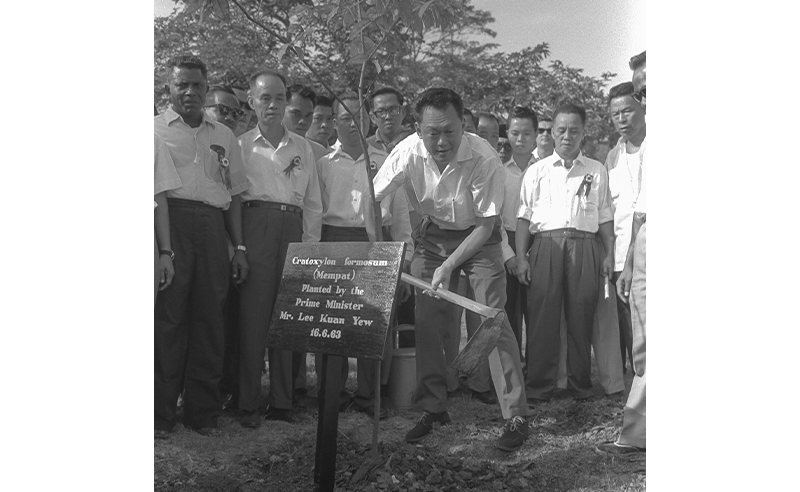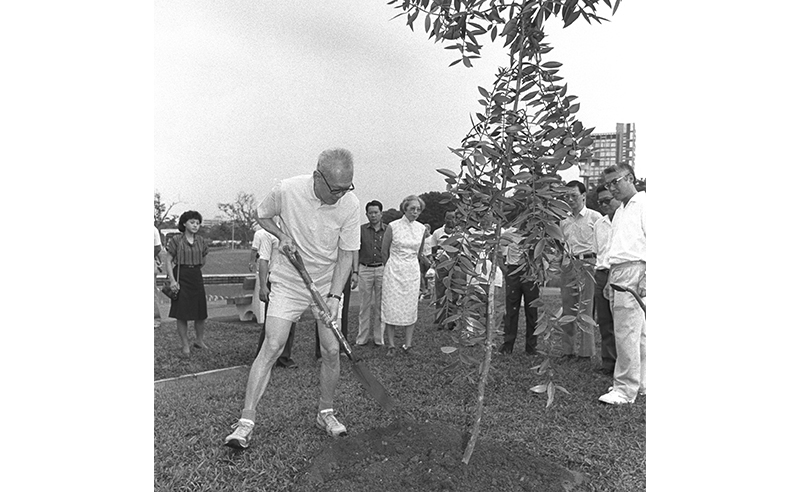The Blossoming of Tree Planting Day
Singapore has planted more than two million trees in the past 50 years. Lim Tin Seng traces the roots of Tree Planting Day.

When acting Prime Minister Goh Keng Swee planted a rain tree sapling on the summit of Mount Faber on a Sunday morning in 1971, there was little to suggest that it was a momentous occasion. The only people present were Goh’s wife, E.W. Barker, the Minister for Law and National Development, as well as senior officials from the Ministry of National Development.
As the Straits Times reported: “There was no fanfare, speeches, no long retinue of assemblymen and PAP [People’s Action Party] party cadres as Dr Goh, in a long-sleeved blue shirt and gold-rimmed sunglasses, potted the sapling into its newly prepared bed.” The event itself was very short. “Within five minutes of Dr Goh’s arrival, the sapling, which is under a year old, was promptly embedded, watered, and was given its name tag on a black plaque.” The report added that groups of tourists, schoolchildren and local sightseers walked past Goh, “totally unaware that history had been planted”.1
What was so special about that Sunday morning some 50 years ago? That day, 8 November 1971, marked the start of what has become an annual ritual in Singapore: Tree Planting Day.
Early Tree Planting Activities
Tree planting in Singapore did not, of course, start in 1971. The practice began in the 19th century and in the early days, it was carried out mainly by the Singapore Municipality and Singapore Botanic Gardens.
The municipality planted trees to either beautify parks and public spaces under its purview or to provide shade along roads such as Battery Road, Orchard Road, Connaught Drive and Jalan Besar. Commonly planted trees include the cotton tree (Ceiba pentandra), angsana (Pterocarpus indicus), flame of the forest (Delonix regia) and rain tree (Samanea saman).

Trees were also planted in the Botanic Gardens for beautification or in its nurseries to support the municipality’s tree planting efforts as well as to experiment with new commercial crops like the pará rubber tree. Between the 1880s and 90s, the Botanic Gardens also carried out a large-scale tree planting programme in an attempt to reforest tracts of land that had once been primary forest but had been cleared to make way for plantations.2
After World War II, the colonial government continued to hold many different tree planting activities. For instance, a tree planting campaign was launched in 1948 by the municipality to replant roadside trees that had been cut down during the Japanese Occupation. In 1955, the Singapore Improvement Trust (SIT) introduced a programme for residents to develop “a greater interest in the well-being of the estate” through tree planting. In the same year, the municipality, now renamed the City Council, also began to plant more flowering trees, such as the red bead tree (Adenanthera pavonina), green ebony (Jacaranda filicifolia) and Madras thorn (Pithecellobium dulce), as roadside trees in an attempt to turn Singapore into a “Garden City of the future”.3
The 1963 Tree Planting Campaign
When the People’s Action Party government came into power in 1959, it continued the practice of tree planting. Prime Minister Lee Kuan Yew believed that it was important for cities to have greenery. “I have always believed that a blighted urban jungle of concrete destroys the human spirit. We need the greenery of nature to lift up our spirits,” he said. “Even in the 1960s, when the Government had to grapple with grave problems of unemployment, lack of housing, health and education, I pushed for the planting of trees and shrubs.”4
In 1963, Lee launched an island-wide tree planting campaign. He noted that such a campaign was needed because Singapore was “becoming barren of trees” and estimated that only one tree had been planted for every 10 that had been felled for building projects. According to a contemporary news report, Lee said that planting more trees “would not only increase the island’s water supply – trees encourage cloud formation and retain moisture that would otherwise be lost – but would make Singapore a pleasanter [sic] place to live in”.5

Lee set a target of planting 10,000 trees annually. Of these, half were to be planted by the government along roads, in housing estates and parks, and the rest by the public. To prevent vandalism in housing estates, Lee suggested that “young trees be guarded by barbed wire”.6
However by April 1967, the government felt that more needed to be done as there was still “a lack of feeling of care for trees among the people” and “a lack of experts” within the government to provide advice on “how best to give scenic beauty to the city”. On 11 May 1967, the Garden City campaign was announced.7
In its early phase, the Garden City campaign was implemented as an intensive tree planting programme. Marked by the planting of fast-growing shrubs and “instant trees”, such as the angsana, rain tree, sea apple (Eugenia grandis) and curtain creeper (Vernonia elliptica), the aim was to produce results in the shortest possible time.
“Once we had greenery over the main parts of the island, we added dashes of colour with free-flowering trees such as the Yellow Flame, and the deep pink Frangipani,” recalled Lee. “We planted colourful Bougainvillea on our overhead pedestrian bridges creating hanging gardens across our roads.” To get variety, he encouraged the Parks and Recreation Department to look for new species of trees and shrubs. “The results of this active search became visible in the 1980s, when swaths of colour began to appear along many of our major roads and in our HDB [Housing & Development Board] new towns,” he said.8
The First Tree Planting Day
Four years after the Garden City vision was unveiled, Tree Planting Day was introduced. While the tree planting event on Mount Faber on 8 November 1971 may have been sparsely attended, it was one of many similar events held around Singapore. These involved students in schools, Singapore Armed Forces units in military camps, as well as cabinet ministers and members of Parliament in the parks and community centres of their constituencies. It was reported that about 8,400 trees and 21,677 shrubs and creepers were planted that day.9
As Minister for Social Affairs Othman Wok put it, the event was to “enhance the aesthetic sense of our younger generation and educate them to be more appreciative of natural beauty and understand the part they have to play in looking after our city and caring for our trees and plants”.10 After planting two purple millettia (Callerya atropurpurea) in Kampong Glam Community Centre, Foreign Minister S. Rajaratnam remarked that tree planting would not only “bring back the rural scene”, but also improve the urban living conditions of the people. He remarked that “Singapore [would] be congenial for living, and [would] avoid the neurotic consequences of people living in concrete jungles”.11
As Lee had been travelling when Tree Planting Day was launched on 8 November, he was not able to take part on the day itself. Instead, he planted a yellow flame tree at Tanjong Pagar Community Centre on 12 December 1971 to mark the occasion.
At the event, he remarked that Tree Planting Day was “Singapore’s most important day”. “Every year, there will be a Tree Planting Day, just before the northeast monsoon begins,” he said. “It would take years before we get the full results. Meanwhile, we must educate all our people – adults, youngsters and motorists parking cars – to nurture and care for trees and not to damage them. Then we shall have a green, cool and luxuriant Singapore.”12
Tree Planting Day in the 1970s and 1980s
Tree Planting Day has been held every year since. It usually involves the entire community from cabinet members, members of Parliament and grassroot leaders to residents, students and the general public.13 In the 1970s, Lee led mass tree planting activities on newly reclaimed land such as East Coast Park and Marina South to kick off Tree Planting Day.14 Some of the trees planted during this period include tembusu (Cyrtophyllum fragrans), eugenia (Syzygium myrtifolium), tamarind (Tamarindus indica) and sea putat (Barringtonia asiatica).15
Fruit trees became the focus of Tree Planting Day in the 1980s. According to Lee, the plan was to start by planting sturdy fruit trees in all HDB estates before moving on to more delicate ones. “We can saturate our housing estates with enough of the hardy fruit trees that can withstand the initial vandalism and pilfering by children,” he said. “Then, in the next stage, we can go for the better fruit trees, after higher social standards of behavior have been the norm.”16 The hope was that gradually, Singapore would be able to nurture a generation with the social discipline to respect and share the fruits of communal property.
Some of the fruit trees planted at the time include popular ones like rambutan (Nephelium lappaceum), coconut (Cocos nucifera), mangosteen (Garcinia mangostana), jambu ayer (Syzygium aqueum), mango (Mangifera indica) and jackfruit (Artocarpus heterophyllus), as well as lesser-known ones like jujube (Ziziphus mauritiana), langsat (Lansium domesticum), kedondong (Canarium pilosum), binjai (Mangifera caesia) and kundang (Bouea macrophylla). As Chua Sian Eng, Commissioner of Parks and Recreation Department (1983–95), noted: “The younger generation has probably never seen any of these fruits. It’s a pity to let these trees, which thrived here for centuries, die out of our environment.”17

Becoming Part of the Clean and Green Campaign
The Tree Planting Day held on 4 November 1990 was a milestone event. Not only did it mark the fulfilment of Lee’s target of planting 100,000 trees, but it was also his last as prime minister.18 He planted two trees that day – a dwarf coconut tree at Spottiswoode Park in Tanjong Pagar and a kuras tree (Dryobalanops oblongifolia) at the Esplanade Park.
Tree Planting Day that year was also significant as it was incorporated into Clean and Green Week, known today as Clean and Green Singapore after it became a year-long event in 2007.
Clean and Green Week was launched by First Deputy Prime Minister Goh Chok Tong with the aim of turning Singapore into a cultivated and gracious society that not only had a clean and green lifestyle, but was also conscious about other environmental issues. Goh said that “[a] total approach to shape and change our attitude towards our environment is needed… Through diligent tree planting and keeping the country clean, the right habit can be conscientiously cultivated. When it becomes our second nature to keep our environment clean and green, it would also be in our nature to be considerate to others by maintaining the environment noise-free, stench-free and irritation-free”.19
Goh used Tree Planting Day to convey messages about environmental protection and sustainability, as well as issues such as reducing pollution, recycling more and minimising waste. During his first decade as prime minister, Goh planted many different species of trees, including the nyatoh puteh (Palaqium obovatum), pulai (Alstonia angustiloba) and the Manila palm (Adonidia merrillii).
One of the most unique trees that Goh “planted” was the “commitment tree” at Marina City Park in 1992.20 Made entirely of recycled materials like aluminum cans and discarded cardboard and bottles, it had “leaves” that allowed people to pen their good intentions towards the environment. After unveiling the tree, Goh “pledge[d] to protect and improve the environment for the health and enjoyment of present and future generations of Singaporeans and guests”.21
Incumbent Prime Minister Lee Hsien Loong continues to observe the tradition of holding Tree Planting Day in November. Over the years, he has planted a variety of trees like the sepetir (Sindora wallichii), api-api putih (Avicennia alba), jelutong (Dyera costulata), cemantung merah (Elaeocarpus mastersii) and Borneo kauri (Agathis borneensis). These were planted all over the island, including the Central Catchment Nature Reserve, Punggol Reservoir, Punggol Waterway Park, Ang Mo Kio and Sengkang.22 Recent years have seen programmes such as live music performances and workshops on creating terrariums as part of the occasion.23
Prime Minister Lee also uses the annual event to highlight important environmental issues such as climate change, energy conservation, waste reduction and recycling. Like Goh, Lee felt that for Singapore to progress into the next stage of greening, it would not only need to be green and clean, but also sustainable.24
Such is the importance of Tree Planting Day that not even a global pandemic could stop it. In 2020, as Covid-19 was sweeping across the world, Lee planted a Buddhist pine (Podocarpus macrophyllus) bonsai tree on a rooftop garden in Hougang to observe that year’s Tree Planting Day. Although the event was held without participation from the community due to social distancing measures, Lee wrote on his Facebook page that he would like all residents to “continue in our efforts to make Singapore a City in Nature”.25
For Tree Planting Day in 2021, Lee planted the same type of tree that his father and founding Prime Minister Lee Kuan Yew did back in 1963, the mempat tree (Cratoxylum formosum), at Ang Mo Kio Avenue 3. Again, due to the pandemic, residents were unable to participate and the event was attended in person by only about 40 people. Said Lee on his Facebook, “It is our responsibility to nurture a more beautiful and sustainable Singapore for future generations. One of the many reasons why we hold Tree Planting Day every year!”26
From Garden City to City in Nature
Over the years, the Garden City vision has morphed into something bigger, and has moved from just greening Singapore into a plan for sustainability.
In 1992, the government released Singapore’s first environmental protection and sustainability blueprint. Known as the Singapore Green Plan, it set out directions to turn Singapore into a model green and sustainable city that was conducive to gracious living, with controls to prevent the generation of pollution and waste. The plan sketched out nature conservation measures to protect the island’s biodiversity and natural environment, and envisioned citizens who would care for the environment and an economy that supported the development of environmental technology.27
This has been supplanted by the 2009 Sustainable Singapore Blueprint that aims to guide Singapore’s sustainable development efforts until 2030. It presented several new initiatives such as turning Singapore into a “City in a Garden”, introducing minimum energy and water efficiency standards for more household appliances, improving the standard and efficiency of public transportation, and creating a Centre for Liveable Cities for knowledge sharing.
Today, the latest sustainability blueprint is the Singapore Green Plan 2030 (Green Plan). Released in 2021, the 10-year plan charts the island’s green targets with the aim of “strengthen[ing] Singapore’s economic, climate and resource resilience, [and] improv[ing] the living environment of Singaporeans” by advancing the national agenda on sustainable development. Some of the targets set by the Green Plan include reducing the country’s carbon emissions, increasing the use of renewable energy, creating new green jobs and building up the country’s climate resistance. The vision was to turn Singapore into a “City in Nature”.28
One of the key initiatives is to plant one million trees across the island by 2030. Called the OneMillionTrees Movement, the heart of this ambitious effort is “the engagement and involvement of community”.29
Since the unveiling of the OneMillionTrees Movement, about 100 individuals and more than 100 groups have pledged their support to plant more than 120,000 trees. Organisations and institutions have also shown similar support – for instance, Keppel Corporation pledged to plant 10,000 trees in parks and nature reserves over the next five years, while the National University of Singapore and Jurong Town Corporation pledged to plant over 80,000 trees on its campus and 30,000 trees on Jurong Island respectively.30
Beyond planting more trees, the OneMillionTrees Movement is about, as Minister for National Development Desmond Lee said, nurturing “a whole new generation of Singaporeans to carry on [the] responsibility to keep planting and nurturing trees for the benefit of future Singaporeans”.31 Some five decades after the initial Tree Planting Day event, it appears that the idea has well and truly taken root.
 Lim Tin Seng is a Librarian with the National Library, Singapore. He is the co-editor of Roots: Tracing Family Histories – A Resource Guide (2013), Harmony and Development: ASEAN-China Relations (2009) and China’s New Social Policy: Initiatives for a Harmonious Society (2010). He writes regularly for BiblioAsia.
Lim Tin Seng is a Librarian with the National Library, Singapore. He is the co-editor of Roots: Tracing Family Histories – A Resource Guide (2013), Harmony and Development: ASEAN-China Relations (2009) and China’s New Social Policy: Initiatives for a Harmonious Society (2010). He writes regularly for BiblioAsia.NOTES
-
“Dr Goh Plants Tree to Launch T-Day,” Straits Times, 8 November 1971, 17. (From NewspaperSG) ↩
-
Lim Tin Seng, “The Greening of Singapore: Parks and Roadside Trees from Colonial Rule to the Present,” Journal of the Malaysian Branch of the Royal Asiatic Society 91, no. 2 (December 2018): 80–82, Project Muse, https://muse.jhu.edu/article/714691; Shawn Lum and IIsa Sharp, eds., A View from the Summit: The Story of Bukit Timah Nature Reserve (Singapore: Nanyang Technological University and National University of Singapore, 1996), 20–21. (From National Library, Singapore, Call no. RSING 333.78095957 VIE) ↩
-
Lim, “Greening of Singapore,” 80–82; “Singapore Replants Trees,” Straits Times, 23 March 1948, 7. (From NewspaperSG) ↩
-
Lee Kuan Yew, “Speech by Mr Lee Kuan Yew, Senior Minister at the Launch of the National Orchid Gardenon Friday, 20 October 1995 at 6.00 pm at the Singapore Botanic Gardens ,” 20 October 1985, transcript. (From National Archives of Singapore, Document no. lky19951020) ↩
-
“‘Plant a Tree’ Drive in S’pore,” Straits Times, 12 June 1963, 9. (From NewspaperSG) ↩
-
“Body to Make People Care for Trees,” Straits Times, 19 April 1967, 13; “S’pore to Become Beautiful, Clean City Within Three Years,” Straits Times, 12 May 1967, 4. (From NewspaperSG) ↩
-
“Dr Goh Plants Tree to Launch T-Day”; “Ministers and MPs,” Straits Times, 2 November 1971, 15. (From NewspaperSG) ↩
-
Othman Wok, “Speech by Inche Othman Wok, Minister for Social Affairs, at the Launching of the Tree-planting Day of the Pasir Panjang Constituency on Sunday, 7th November, 1971, at 9.00 a.m. at the Pasir Panjang Community Centre,” 7 November 1971, transcript. (From National Archives of Singapore, Document no. PressR19711107a) ↩
-
“S’pore Will Avoid Mistake of Big Cities, Says Raja,” Straits Times, 8 November 1971, 17. (From NewspaperSG) ↩
-
“Keep Eye on World Scene Too, Says Lee,” Straits Times, 13 December 1971, 16. (From NewspaperSG) ↩
-
Timothy Auger, Living in a Garden: The Greening of Singapore (Singapore: Editions Didier Millet, 2013), 27. (From National Library, Singapore, Call no. RSING 363.68095957 AUG) ↩
-
Evangeline Gamboa, “PM Planted It 11 Years Ago…,” Straits Times, 6 November 1983, 12; “Lee to ‘Spade In’ Tree Planting Day,” Straits Times, 9 November 1975, 5; “Mr Lee Sets Example on Tree Planting Day,” Straits Times, 7 November 1977, 15; “PM Launches Tree Planting Day,” Straits Times, 6 November 1978, 1; “People and VIPs Dig in on Tree Planting Day,” Straits Times, 5 November 1979, 10. (From NewspaperSG) ↩
-
Gamboa, “PM Planted it 11 years ago….”; “Lee to ‘Spade In”; “Mr Lee Sets Example on Tree Planting Day”; “PM Launches Tree Planting Day”; “People and VIPs Dig in on Tree Planting Day”; Maureen Chua, “A Tembusu By Lee Starts Off Tree Planting Day,” Straits Times, 5 November 1973, 15; “Lee Starts Off Tree Planting Day at East Coast,” Straits Times, 4 November 1974, 8. (From NewspaperSG) ↩
-
Lee Kuan Yew, “Speech by Prime Minister Lee Kuan Yew at the Opening of the 3rd Horticulture and Aquarium Fish Show on 17 Sep 80 at World Trade Centre,” 17 September 1980, transcript. (From National Archives of Singapore, Document no. lky19800917) ↩
-
Lee Siew Hua, “Bringing Back Our ‘Forgotten’ Fruits,” Straits Times, 3 November 1985, 2. (From NewspaperSG) ↩
-
Cherian George, “Mr Lee Plants Last Tree as PM,” Straits Times, 5 November 1990, 23. (From NewspaperSG) ↩
-
Goh Chok Tong, “Speech by Mr Goh Chok Tong, First Deputy Prime Minister and Minister for Defence, at the Launching of ‘Clean and Green Week… Green for Life’, at Esplanade Park on Sunday, 4 November 1990, at 10.00 pm,” 4 November 1990, transcript. (From National Archives of Singapore, Document no. gct19901104) ↩
-
Cherian George, “PM: S’pore Committed to Protecting Environment,” Straits Times, 8 November 1993, 1; “Next Year ‘an Apt Time to Reward Nation Builders’,” Straits Times, 7 November 1994, 1; Hong Lee Tiam, “ENV Plan to Help Industries Avoid Waste, Conserve Resources,” Business Times, 2 November 1992, 1; “A ‘Tree’ to Save the Environment,” Straits Times, 2 November 1992, 1. (From NewspaperSG) ↩
-
Amanda Lee, “PM Lee Joins Residents in Reforestation Efforts,” Today, 4 November 2013, 16. (From NewspaperSG); Chong Zi Liang, “PM Lee Marks Tree Planting Day by Planting a Tropical Mangrove Tree – on Water,” Straits Times, 13 November 2016, https://www.straitstimes.com/singapore/environment/pm-lee-marks-tree-planting-day-by-planting-a-tropical-mangrove-tree-on-water; Yuen Sin, “PM Lee Joins Residents for Annual Tree Planting in Fernvale Lane,” Straits Times, 4 November 2018, https://www.straitstimes.com/singapore/pm-lee-joins-residents-for-annual-tree-planting-in-fernvale-lane; Walter Sim, “PM Lee Plants Tree, Launches SG50 Clean and Green Carnival in Punggol,” Straits Times, 31 October 2015, https://www.straitstimes.com/singapore/environment/pm-lee-plants-tree-launches-sg50-clean-and-green-carnival-in-punggol. ↩
-
“Planting Roots in the Community,” Straits Times, 9 November 2015, 4. (From NewspaperSG) ↩
-
Lim Yan Liang, “Recycling, Energy-Saving to Figure in Green Plan,” Straits Times, 2 November 2014, 4. (From NewspaperSG) ↩
-
Lee Hsien Loong, “Good to Meet Up with My Fellow AMK Grassroots Advisors. Let Us All Continue in Our Efforts to Make Singapore a City in Nature!,” 1 November 2020, Facebook, https://www.facebook.com/leehsienloong. ↩
-
Justin Ong, “PM Lee Plants Same Type of Tree on Annual Tree Planting Day as Father Did in 1963,” The Straits Times, 20 November 2021, https://www.straitstimes.com/singapore/community/pm-lee-plants-symbolic-cherry-blossom-like-tree-as-ang-mo-kio-steps-up-green ↩
-
Azra Moiz, The Singapore Green Plan: Action Programmes (Singapore: Times Editions Pte Ltd, 1993), 9–10. (From National Library, Singapore, Call no. RSING 363.7095957 SIN) ↩
-
Audrey Tan, “Singapore Green Plan 2030 to Change the Way People Live, Work, Study and Play,” Straits Times, 10 February 2021, https://www.straitstimes.com/singapore/environment/singapore-green-plan-2030-to-change-the-way-people-live-work-study-and-play; Ang Hwee Min and Mathew Mohan, “Singapore Unveils Green Plan 2030, Outlines Green Targets for Next 10 Years,” Channel NewsAsia, 10 February 2021, https://www.channelnewsasia.com/news/singapore/singapore-green-plan-2030-targets-10-years-14161356 ↩
-
“About the Movement”, National Parks Board, last updated 10 September 2021, https://www.nparks.gov.sg/treessg/one-million-trees-movement/about-the-movement; Cindy Co, “Singapore to Plant 1 Million Trees, Develop More Gardens and Parks by 2030,” Channel NewsAsia, 4 March 2020, https://www.channelnewsasia.com/news/singapore/singapore-to-plant-1-million-trees-develop-more-gardens-and-12500858. ↩
-
“About the Movement”; Co, “Singapore to Plant 1 Million Trees, Develop More Gardens and Parks by 2030.” ↩
-
“Speech by 2M Desmond Lee at the Committee of Supply Debate 2020 – Transforming Singapore into a City of Nature,” Ministry of National Development, 4 March 2020, https://www.mnd.gov.sg/newsroom/speeches/view/speech-by-2m-desmond-lee-at-the-committee-of-supply-debate-2020—transforming-singapore-into-a-city-of-nature. ↩

